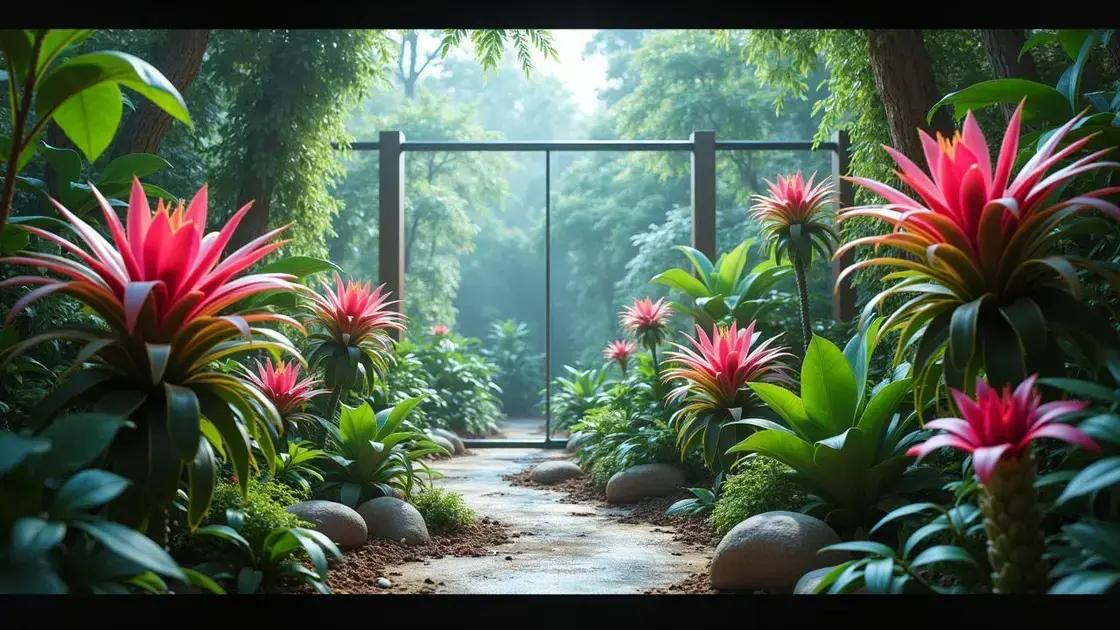How to Care for a Bromeliad House Plant: 5 Expert Tips for Thriving Growth
How to care for a bromeliad house plant can be a daunting question for new plant enthusiasts. These exotic beauties can thrive in your home with the right guidance. Dive into the world of bromeliad care and discover the secrets to keeping these stunning plants healthy and vibrant.
Table of Contents
ToggleUnderstanding the unique needs of bromeliad plants
How to care for a bromeliad house plant involves understanding the unique needs of these stunning tropical plants. Bromeliads are not just beautiful; their maintenance is straightforward if you know what they require. Let’s dive into the essential aspects that will help you nurture your bromeliad to its fullest potential.
Key characteristics of bromeliads
- They thrive in both indoor and outdoor settings.
- They need well-draining potting soil, which can vary based on the specific bromeliad variety.
- Bromeliads can store water in their leaf rosettes, making them adaptable.
Water requirements for bromeliads
Bromeliads have specific watering needs that differ from typical houseplants. The ideal watering method includes:
- Water the central cup (the leaf rosette) regularly, ensuring it doesn’t dry out.
- Use distilled or rainwater to avoid mineral buildup.
- Empty the water after rainstorms to prevent rot.
Sunlight needs for bromeliads
Understanding your bromeliad’s light requirements is crucial for its growth. Here are some guidelines:
- Most bromeliads prefer bright, indirect sunlight.
- Avoid direct sunlight, as it can scorch their leaves.
- Rotate the plant periodically to ensure even growth.
Common pests and diseases
Bromeliads can be susceptible to specific pests and diseases. Keep an eye on the following:
- Spider mites: Look for fine webbing on the leaves.
- Mealybugs: Identify these white fuzzy insects on the leaf joints.
- Root rot: Monitor for mushy roots by ensuring proper drainage.
For further guidance on enhancing your bromeliad plant maintenance, consider exploring indoor gardening techniques. With the right care and understanding of their unique needs, your bromeliads will thrive and enhance your living space.
Essential watering tips for your bromeliad

Essential watering tips for your bromeliad are crucial for the health and vitality of your plant. Understanding how to properly hydrate these unique houseplants ensures they thrive and maintain their vibrant colors. Here are some key pointers to help you master the art of watering your bromeliad effectively.
Watering methods for bromeliads
To optimize your bromeliad’s health, consider the following watering techniques:
- Central cup watering: Fill the rosette or the central cup with water. This is essential as bromeliads are epiphytes and naturally collect water in their leaf structures.
- Water quality: Use distilled water or rainwater to avoid chemical buildup that can harm the plant.
- Drainage: Always ensure that excess water can drain out to prevent root rot.
Frequency of watering
Finding the right frequency to water your bromeliad can vary based on environment and season. Follow these guidelines:
- Check the soil moisture. Water the plant once the top inch of soil feels dry.
- In warm months, you may need to water your bromeliad every 1-2 weeks.
- During cooler months, reduce watering to every 2-4 weeks.
Signs of improper watering
Recognizing symptoms of overwatering or underwatering is essential. Look for:
- Overwatering: Yellowing leaves or mushy roots can indicate excessive moisture.
- Underwatering: Browning leaf tips or curling leaves may signal a lack of water.
- Adjust your watering routine based on these signs.
For more insights into enhancing your bromeliad care, consider exploring indoor gardening techniques that will complement your efforts in nurturing these splendid plants.
Optimal light conditions for healthy bromeliads
Optimal light conditions for healthy bromeliads are critical for promoting growth and vibrant blooms. Understanding how much light your bromeliad needs will ensure it thrives in your home environment. Here’s what you need to know to provide the perfect lighting for your bromeliad.
Understanding light requirements
- Bromeliads prefer bright, indirect light rather than direct sunlight.
- Too much direct sunlight can scorch the leaves, leading to browning tips.
- Low light conditions may result in slow growth and reduced flower production.
Best light sources for bromeliads
When determining where to place your bromeliad, consider these ideal light sources:
- Near a window: Position your bromeliad near an east or north-facing window where it can receive bright, diffused light.
- Grow lights: If natural light is lacking, use full-spectrum grow lights to supplement the light your plant receives.
- Avoid dark corners: Keep bromeliads away from areas that receive insufficient light to ensure healthy growth.
Signs of improper lighting
To keep your plant healthy, watch for signs that it may not be receiving the right light:
- Yellow leaves: This could indicate too much direct sunlight.
- Pale or stretched leaves: These signs may suggest your bromeliad needs more light.
- Adjust lighting based on these clues to maintain your plant’s health.
For more insights into creating the best conditions for your bromeliad, consider exploring indoor gardening techniques. Providing proper light conditions is an essential step in ensuring your bromeliad flourishes.
In conclusion
Caring for a bromeliad house plant can be a rewarding journey when you understand its unique needs. From essential watering tips to optimal light conditions, each aspect contributes to the overall health of your bromeliad. By providing the right environment and practicing attentive maintenance, these stunning plants can flourish and enhance your indoor space beautifully. For more insights, explore tips on enhancing your indoor garden and elevate your plant care game.

